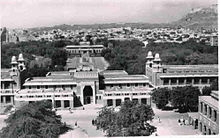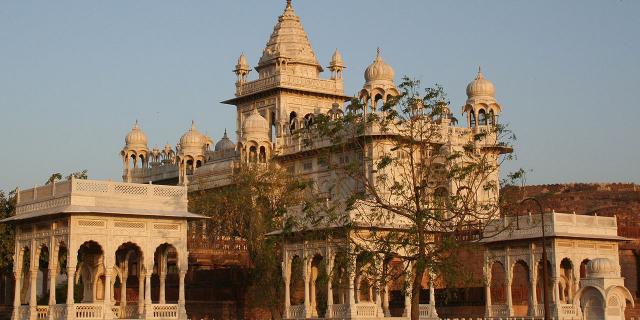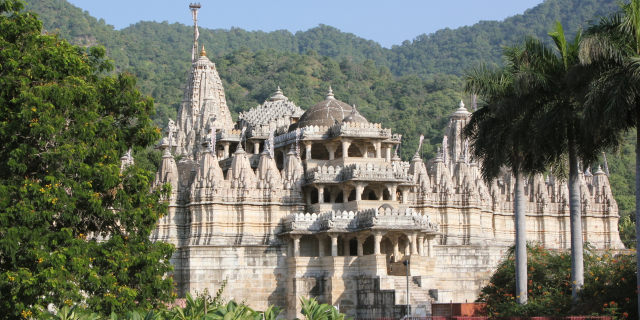जोधपुर
( Jodhpur )
Jodhpur ( pronounced [ˈd͡ʒoːd̪ʱpʊr] ) is the second-largest city in the Indian state of Rajasthan and officially the second metropolitan city of the state. It serves as the administrative headquarters of the Jodhpur district and Jodhpur division. Jodhpur was historically the capital of the Kingdom of Marwar, which is now part of Rajasthan. Jodhpur is a popular tourist destination, featuring many palaces, forts, and temples, set in the stark landscape of the Thar Desert. It is popularly known as the Blue City as all the buildings in the oldest district are painted in a light shade of blue.
The old city circles the Mehrangarh Fort and is bounded by a wall with several gates. The city has expanded greatly outside the wall, though over the past several decades. Jodhpur lies near the geographic centre of the Rajasthan state, which makes it a convenient base for travel in a reg...Read more
Jodhpur ( pronounced [ˈd͡ʒoːd̪ʱpʊr] ) is the second-largest city in the Indian state of Rajasthan and officially the second metropolitan city of the state. It serves as the administrative headquarters of the Jodhpur district and Jodhpur division. Jodhpur was historically the capital of the Kingdom of Marwar, which is now part of Rajasthan. Jodhpur is a popular tourist destination, featuring many palaces, forts, and temples, set in the stark landscape of the Thar Desert. It is popularly known as the Blue City as all the buildings in the oldest district are painted in a light shade of blue.
The old city circles the Mehrangarh Fort and is bounded by a wall with several gates. The city has expanded greatly outside the wall, though over the past several decades. Jodhpur lies near the geographic centre of the Rajasthan state, which makes it a convenient base for travel in a region much frequented by tourists. The city featured in The New York Times's "52 Places to Go in 2020".
Jodhpur city was founded in 1459 by Rao Jodha, a Rajput chief of the Rathore clan. Jodha succeeded in conquering the surrounding territory from the Delhi Sultanate and thus founded a kingdom that came to be known as Marwar.[1] As Jodha hailed from the nearby town of Mandore, that town initially served as the capital of this state; however, Jodhpur soon took over that role, even during the lifetime of Jodha. The city was located on the strategic road linking Delhi to Gujarat. This enabled it to profit from a flourishing trade in opium, copper, silk, sandalwood, dates, and other tradeable goods.[2]
Early modern periodAfter the death of Rao Chandrasen Rathore in 1581, the kingdom was annexed by the Mughal Emperor Akbar, Marwar thus became a Mughal vassal, owing fealty to them while enjoying internal autonomy. Jodhpur and its people benefited from this exposure to the wider world as new styles of art and architecture made their appearance and opportunities opened up for local tradesmen to make their mark across northern India.[2]
 View of the Rajasthan High Court, Sardar Museum in Umaid Park and upper right is Jodhpur fort in 1960.
View of the Rajasthan High Court, Sardar Museum in Umaid Park and upper right is Jodhpur fort in 1960.Aurangzeb briefly sequestrated the state (circa 1679) after the death of Maharaja Jaswant Singh, but the prior ruler Maharaja Ajit Singh was restored to the throne by Veer Durgadas Rathore after Aurangzeb died in 1707 and a great struggle of 30 years. The Mughal empire declined gradually after 1707, but the Jodhpur court was beset by intrigue; rather than benefiting from circumstances, Marwar descended into strife and invited the intervention of the Marathas, who soon supplanted the Mughals as overlords of the region. In 1755 Jai Appa Scindia attacked on Nagaur after looted several places of Rajasthan. Jai Appa halted his army near samas pond of Tausar which was 3.5 Km from Nagaur fort. He surrounded Nagaur fort and cut off food and water supply. Maharaja Vijay Singh ji called Darbar and asked volunteer to kill Scindia. Gaji Khan Khokhar (Chawata Kallan) and Kan Singh (Dotalai) were volunteered and taken responsibility to kill Jaiappa ji Scindia. Both changed their outfit as trader's and open shop near Jaiappa ji army. They observed their activities for two month. On 25 Jul 1755 on Friday at 11 am ,when found opportunity attacked on Jaiappa with daggers and killed him (Painting situated in Mandore musium). While fighting both the loyal Soldier of Jodhpur Martyred. From than a common proverb still people say "Khokhar bada khuraki kha gaya appa jaisa daaki" (Khokhar are great gluttons, eaten demon like appa). Even after killing of Jai Appa Sindhia Maratha army continued fighting for few month near Nagaur but they lost hope after Jai Appa death.This did not make for stability or peace, however; 50 years of wars and treaties.
Dissipated the wealth of the state, which sought the help of the British and entered into a subsidiary alliance with them.[2][3]
British colonial periodA major revolt occurred in 1857 by some Rathore nobles of Pali led by Thakur Kushal Singh of Auwa, but the rebels were defeated by the British Army under Colonel Holmes and peace was restored.[2][4]
 Street Scene of Jodhpur in 1906
Street Scene of Jodhpur in 1906During the British Raj, the state of Jodhpur had the largest land area of any in the Rajputana. The land area of the state was 93,424 km2 (36,071 sq mi) its population in 1901 was 44,73,759. It enjoyed an estimated revenue of £3,529,000. Its merchants, the Marwaris, flourished and came to occupy a position of dominance in trade across India.
After independenceIn 1947, when India became independent, the state merged into the union, and Jodhpur became the second-largest city of Rajasthan.[2][5] At the time of division, the ruler of Jodhpur, Hanwant Singh, did not want to join India, but finally, due to the effective persuasion of Vallabhbhai Patel at the time, the state of Jodhpur was included in the Indian Republic. Later after the State Reorganisation Act, 1956, it was included within the state of Rajasthan.[2]

































Add new comment